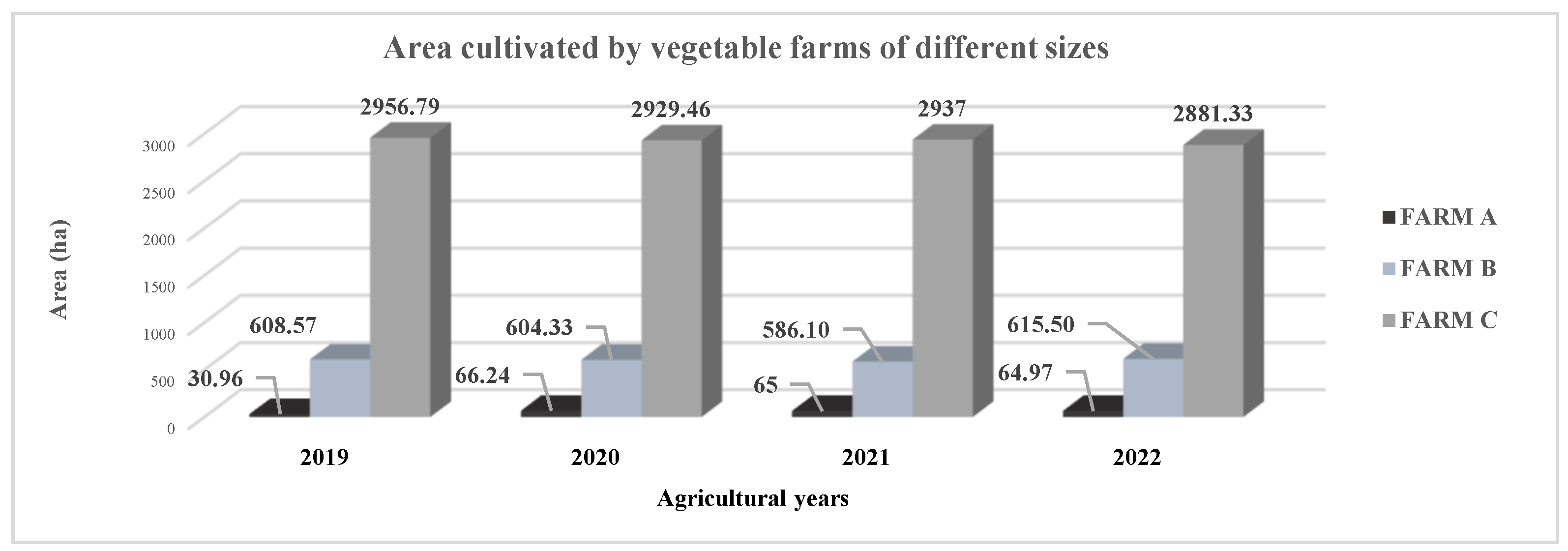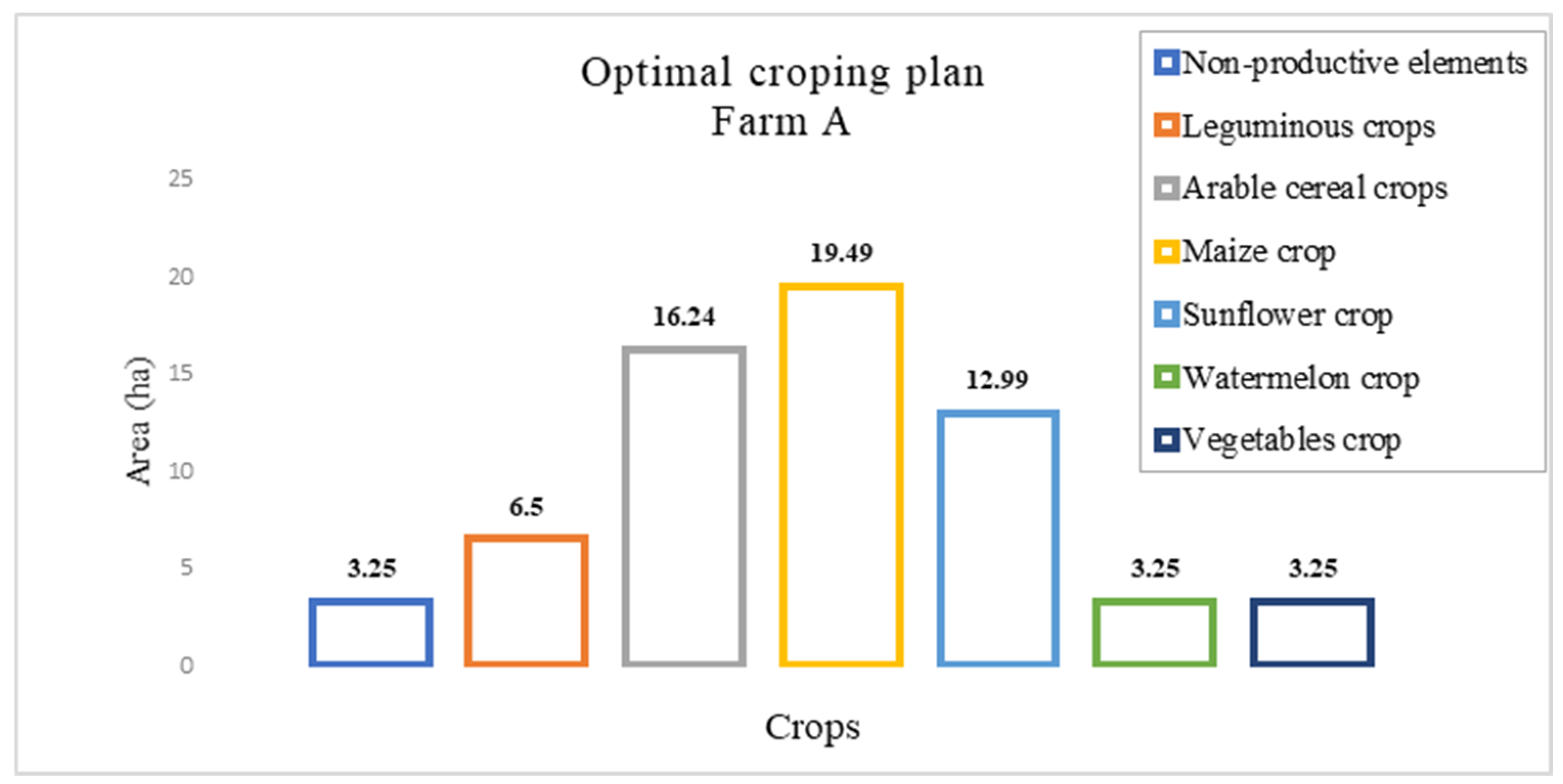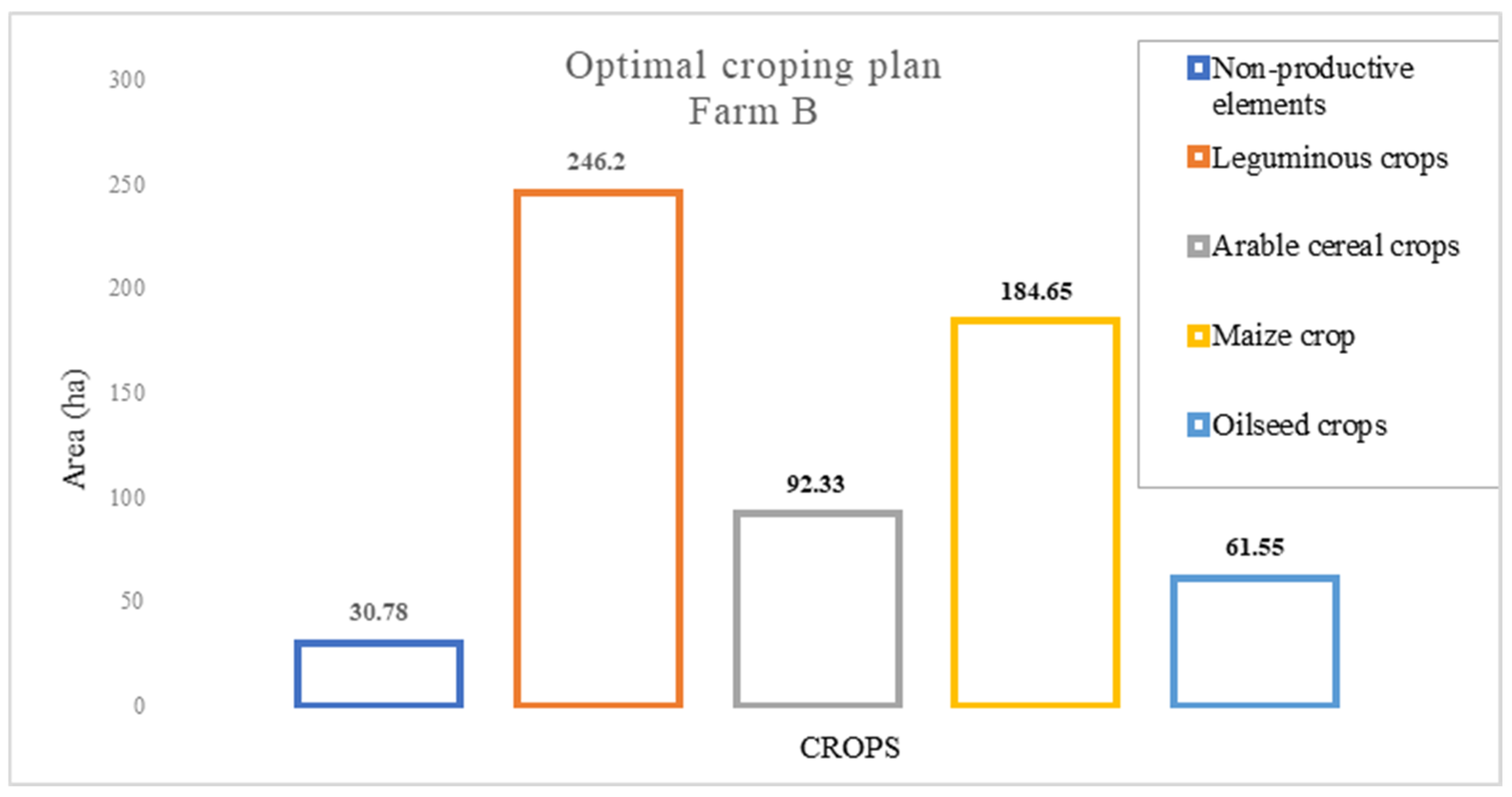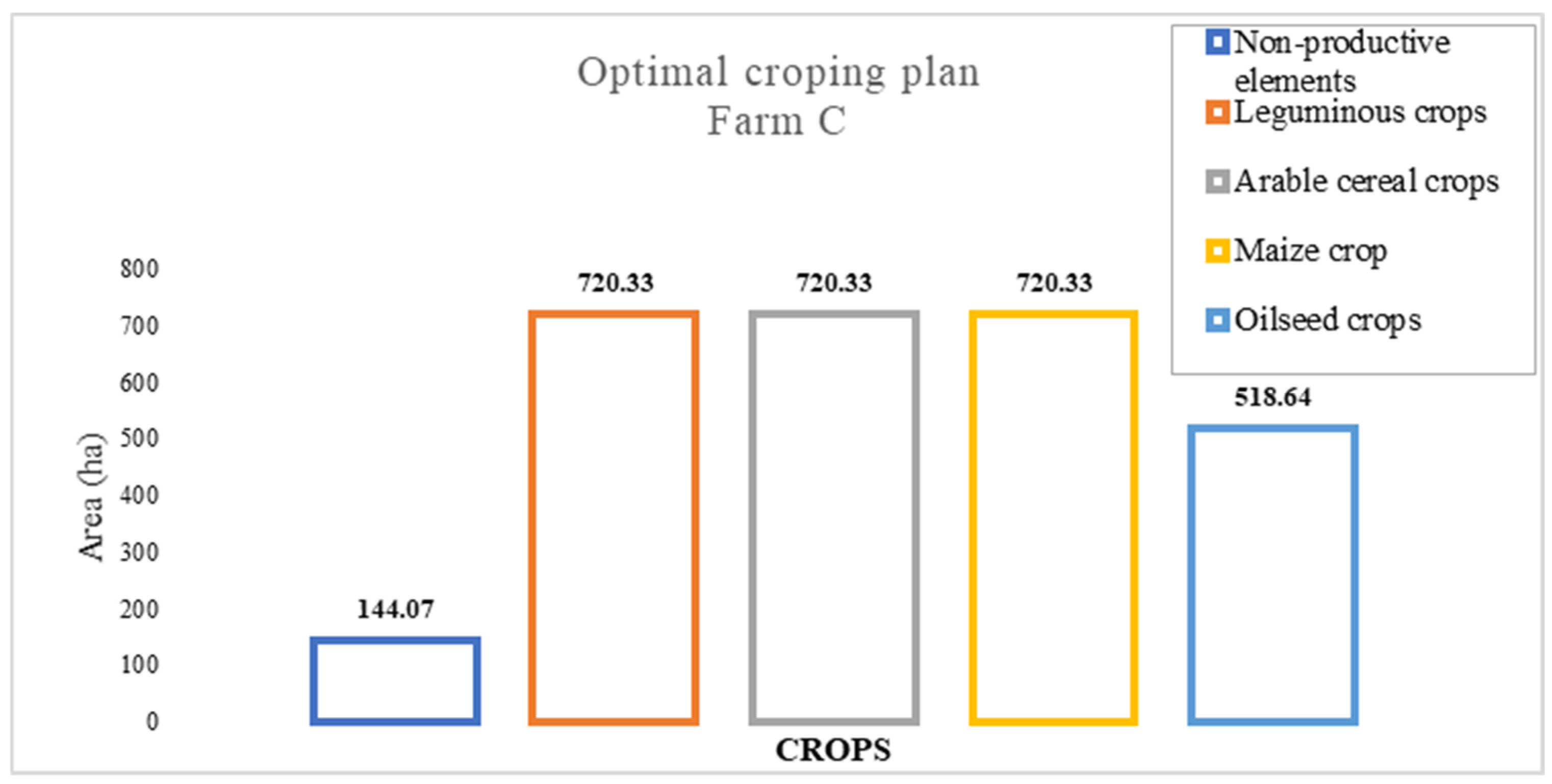Crop Rotation Practiced by Romanian Crop Farms before the Introduction of the “Environmentally Beneficial Practices Applicable to Arable Land” Eco-Scheme
Abstract
1. Introduction
2. Materials and Methods
3. Results and Discussions
3.1. Analysis Regarding Rotation and Crop Rotation System on the 60 ha Farm (Farm A)
3.2. Analysis Regarding Rotation and Crop Rotation System on the 600 ha Farm (Farm B)
3.3. Analysis Regarding Rotation and Crop Rotation System on the 3000 ha Farm (Farm C)
3.4. Discussions on the Implementation of Eco-Scheme Conditions at a Farm Level
3.5. Optimum Cropping Plan Recommendations for the Three Large Crop Farms
4. Conclusions
- -
- Farms under 100 ha (Farm A) which do not apply modern technologies and have fragmented surfaces must have both uncultivated surfaces and nitrogen-fixing crops, but also practice crop diversification.
- -
- Farms of over 100 ha (Farms B and C) must implement the eco-scheme by including non-productive areas on 5% of the surface. As the rest of the conditions are already met, these farms have the ability to practice a conservative type of agriculture and use crop diversification, including growing nitrogen-fixing plants.
Supplementary Materials
Author Contributions
Funding
Data Availability Statement
Acknowledgments
Conflicts of Interest
References
- Beckers, V.; Beckers, J.; Vanmaercke, M.; Van Hecke, E.; Van Rompaey, A.; Dendoncker, N. Modeling Farm Growth and Its Impact on Agricultural Land Use: A Country Scale Application of an Agent-Based Model. Land 2018, 7, 109. [Google Scholar] [CrossRef]
- Agathokleous, E.; Kitao, M.; Komatsu, M.; Tamai, Y.; Harayama, H.; Koike, T. Single and combined effects of fertilization, ectomycorrhizal inoculation, and drought on container-grown Japanese larch seedlings. J. For. Res. 2023, 34, 1077–1094. [Google Scholar] [CrossRef]
- Kussul, N.; Deininger, K.; Shumilo, L.; Lavreniuk, M.; Ali, D.A.; Nivievskyi, O. Biophysical Impact of Sunflower Crop Rotation on Agricultural Fields. Sustainability 2022, 14, 3965. [Google Scholar] [CrossRef]
- Kirk, N.A.; Cradock-Henry, N.A. Changing land management as an adaptation to climate and other stressors: A systematic review of decision contexts using values-rules-knowledge. Land 2022, 11, 791. [Google Scholar] [CrossRef]
- National Strategic Plan of Romania 2023–2027. Available online: https://apia.org.ro/wp-content/uploads/2023/01/Plan-National-Strategic-PAC-2023-2027_v1.2.pdf (accessed on 20 April 2023).
- Osei, E.; Jafri, S.H.; Gassman, P.W.; Saleh, A. Simulated Eco, system and Farm-Level Economic Impacts of Conservation Tillage in a Northeastern Iowa County. Agriculture 2023, 13, 891. [Google Scholar] [CrossRef]
- Yu, T.; Mahe, L.; Li, Y.; Wei, X.; Deng, X.; Zhang, D. Benefits of Crop Rotation on Climate Resilience and Its Prospects in China. Agronomy 2022, 12, 436. [Google Scholar] [CrossRef]
- Fendji, J.L.E.K.; Kenmogne, C.T.; Fotsa-Mbogne, D.J.; Förster, A. Improving Farmers’ Revenue in Crop Rotation Systems with Plot Adjacency Constraints in Organic Farms with Nutrient Amendments. Appl. Sci. 2021, 11, 6775. [Google Scholar] [CrossRef]
- Li, J.; Huang, L.; Zhang, J.; Coulter, J.A.; Li, L.; Gan, Y. Diversifying crop rotation improves system robustness. Agron. Sustain. Dev. 2019, 39, 38. [Google Scholar] [CrossRef]
- EU Regulation No. 2115/2021, of the European Parliament and of the Council of December 2, 2021 Establishing the Rules Regarding the Support for the Strategic Plans to Be Drawn Up by the Member States within the Framework of the Common Agricultural Policy (CAP Strategic Plans) and Financed by the European Agricultural Guarantee Fund (FEGA) and the European Agricultural Fund for Rural Development (EAFRD) and Repealing Regulations (EU) No. 1305/2013 and (EU) No. 1307/2013. Available online: https://eur-lex.europa.eu/legal-content/RO/TXT/PDF/?uri=CELEX:32021R2115&from=EN (accessed on 10 April 2023).
- Stoicea, P.; Certan, I.; Dobre, C.A.; Iorga, A.M.; Chiurciu, I.-A.; Balan, A. Agriculture and environmentally beneficial practices applicable to arable land introduced through the eco-scheme. In Economic Growth under Globalization Conditions, 16th ed.; INCE: Chisinau, Moldova, 2022; Volume 1, p. 367. ISBN 978-9975-3583-6-10. [Google Scholar]
- Jiao, W.; Yu, Z.; Sun, Y.; Liu, Y. An Analytical Framework for Formulating Conservation and Development Measures for Important Agricultural Heritage Systems. Sustainability 2023, 15, 4439. [Google Scholar] [CrossRef]
- Tapalăgă, M.; Vlad, V.; Şileţchi, C.; Doucet, I.; Tuhai, A.; Cârstea, S.; Baicu, T. System of Programs for the Management of Databases Regarding the Tracking of the Research-Development Plan at National Level and Unit of Agricultural Research. Proceedings of the National Symposium on Informatics in Agricultural, Forestry and Food Industry Research (ASAS, Bucharest, May 1996), ASAS Courier, 1997, Offers of Informatics in Agricultural Fields (Special Issue). 1997. Available online: https://icpa.ro (accessed on 20 February 2023).
- The Payment Requests of the Three Crop Farms of Different Sizes, for the Granting of Subsidies by the Agency for Payments and Interventions in Agriculture, in the Period 2019–2022. Available online: https://apia.org.ro/ (accessed on 2 April 2023).
- Chmieliński, P.; Wrzaszcz, W.; Zieliński, M.; Wigier, M. Intensity and Biodiversity: The ‘Green’ Potential of Agriculture and Rural Territories in Poland in the Context of Sustainable Development. Energies 2022, 15, 2388. [Google Scholar] [CrossRef]
- Micu, M.M.; Dinu, T.A.; Fintineru, G.; Tudor, V.C.; Stoian, E.; Dumitru, E.A.; Stoicea, P.; Iorga, A. Climate Change—Between “Myth and Truth” in Romanian Farmers’ Perception. Sustainability 2022, 14, 8689. [Google Scholar] [CrossRef]
- Wezel, A.; Bellon, S.; Doré, T.; Francis, C.; Vallod, D.; David, C. Agroecology as a science, a movement and a practice: A review. Agron. Sustain. Dev. 2009, 29, 503–515. [Google Scholar] [CrossRef]
- Weißhuhn, P.; Reckling, M.; Stachow, U.; Wiggering, H. Supporting Agricultural Ecosystem Services through the Integration of Perennial Polycultures into Crop Rotations. Sustainability 2017, 9, 2267. [Google Scholar] [CrossRef]
- He, D.-C.; Ma, Y.-L.; Li, Z.-Z.; Zhong, C.-S.; Cheng, Z.-B.; Zhan, J. Crop Rotation Enhances Agricultural Sustainability: From an Empirical Evaluation of Eco-Economic Benefits in Rice Production. Agriculture 2021, 11, 91. [Google Scholar] [CrossRef]
- Jiang, X.; Wright, A.L.; Wang, J.; Li, Z. Long-term tillage effects on microbial biomass distribution patterns and activities in soil aggregates. Catena 2011, 87, 276–280. [Google Scholar] [CrossRef]
- Dube, E.; Chiduza, C.; Muchaonyerwa, P. Effects of conservation agriculture on soil organic matter on a haplic Cambisol after four years of maize-oat fallow and grazing rotations in South Africa. Tillage Res. 2012, 123, 21–28. [Google Scholar] [CrossRef]
- Busari, M.A.; Kukal, S.S.; Kaur, A.; Bhatt, R.; Dulazi, A.A. The impact of conservation works on soil, crops and the environment. Int. Soil Water Conserv. Res. 2015, 3, 119–129. [Google Scholar] [CrossRef]
- Margenot, A.J.; Paul, B.K.; Sommer, R.R.; Pulleman, M.M.; Parikh, S.J.; Jackson, L.E.; Fonte, S.J. Can conservation agriculture improve phosphorus (P) availability in weathered soils? Effects of tillage and residue management on soil P status after 9 years in a Kenyan Oxisol. Tillage Res. 2017, 166, 157–166. [Google Scholar] [CrossRef]
- Zhang, X.; Zhu, A.; Xin, X.; Yang, W.; Zhang, J.; Ding, S. Soil and residue management for long-term wheat and maize cropping in the North China Plain: I. Crop yield and integrated soil fertility index. Field Crops Res. 2018, 221, 157–165. [Google Scholar] [CrossRef]
- Boincean, B.; Volo, L.; Rurac, M.; Hurmuzachi, I.; Baltag, G. Conservative Agriculture—Manual for Agricultural Producers and Trainers, Chisinau. 2020. Available online: http://dspace.usarb.md:8080/xmlui/bitstream/handle/123456789/4639/Boincean_Agricultura_Conservativa.pdf?sequence=1&isAllowed=y (accessed on 18 February 2023).
- Rurac, M.; Zbancă, A.; Baltag, G.; Bacean, I.; Cazmalî, N.; Bostan, M. Practical Guide in the Field of Conservation Agriculture, Chisinau. 2021. Available online: https://www.ucipifad.md/wp-content/uploads/2020/07/ghid_Agricultura-conservativ%C4%83-%E2%80%93-solu%C8%9Bie-indispensabil%C4%83_2021_.pdf (accessed on 16 February 2023).
- Grzebisz, W.; Diatta, J.; Barłóg, P.; Biber, M.; Potarzycki, J.; Łukowiak, R.; Przygocka-Cyna, K.; Szczepaniak, W. Soil Fertility Clock—Crop Rotation as a Paradigm in Nitrogen Fertilizer Productivity Control. Plants 2022, 11, 2841. [Google Scholar] [CrossRef]
- Hobbs, P.R.; Sayre, K.; Gupta, R. The role of conservation agriculture in sustainable agriculture. Philos. Trans. R. Soc. B 2007, 363, 543–555. [Google Scholar] [CrossRef] [PubMed]
- Calegari, A.; Hargrove, W.L.; Rheinheimer, D.D.; Ralisch, R.; Tessier, D.; de Tourdonnet, S.; Guimaraes, M.D. Impact of long-term no-tillage and cropping system management on soil organic carbon in an Oxisol: A model for sustainability. Agron. J. 2008, 100, 1013–1019. [Google Scholar] [CrossRef]
- Campbell, C.A.; McConkey, B.G.; Zentner, R.P.; Dyck, F.B.; Selles, F.; Curtin, D. Tillage and crop rotation effects on soil organic C and N in a coarse- textured Typic Haploboroll in south-western Saskatchewan. Soil Tillage Res. 1996, 37, 3–14. [Google Scholar] [CrossRef]
- Dury, J.; Schaller, N.; Garcia, F.; Reynaud, A.; Bergez, J.E. Models to support cropping plan and crop rotation decisions. A review. Agron. Sustain. Dev. 2011, 32, 567–580. [Google Scholar] [CrossRef]
- Reckling, M.; Hecker, J.-M.; Bergkvist, G.; Watson, C.A.; Zander, P.; Schläfke, N.; Stoddard, F.L.; Eory, V.; Topp, C.F.E.; Maire, J.; et al. A cropping system assessment framework—Evaluating effects of introducing legumes into crop rotations. Eur. J. Agron. 2016, 76, 186–197. [Google Scholar] [CrossRef]
- Dogliotti, S.; Rossing, W.A.H.; van Ittersum, M.K. Rotat, a tool for systematically generating crop rotations. Eur. J. Agron. 2003, 19, 239–250. [Google Scholar] [CrossRef]
- Chen, X.; Jiang, L.; Zhang, G.; Meng, L.; Pan, Z.; Lun, F.; An, P. Green-depressing cropping system: A referential land use practice for fallow to ensure a harmonious human-land relationship in the farming-pastoral ecotone of northern China. Land Use Policy 2021, 100, 104917. [Google Scholar] [CrossRef]
- Kwiatkowski, C.A.; Harasim, E. Chemical Properties of Soil in Four-Field Crop Rotations under Organic and Conventional Farming Systems. Agronomy 2020, 10, 1045. [Google Scholar] [CrossRef]
- Liang, L.; Wang, Y.; Ridoutt, B.G.; Lal, R.; Wang, D.; Wu, W.; Wang, L.; Zhao, G. Agricultural subsidies assessment of cropping system from environmental and economic perspectives in North China based on LCA. Ecol. Indic. 2019, 96, 351–360. [Google Scholar] [CrossRef]
- Haruna, S.I.; Nkongolo, N.V. Tillage, Cover Crop and Crop Rotation Effects on Selected Soil Chemical Properties. Sustainability 2019, 11, 2770. [Google Scholar] [CrossRef]
- Guo, J.; Lin, H.; Jiang, S. Enzymic activity of alkaline meadow soil with different grassland vegetations. Chin. J. Appl. Ecol. 1997, 8, 412–416. [Google Scholar]




| Crop | 2019 | 2020 | 2021 | 2022 | ||||
|---|---|---|---|---|---|---|---|---|
| ha | % | ha | % | ha | % | ha | % | |
| Winter wheat | 8.69 | 28.07 | 37.44 | 56.52 | 32.83 | 50.51 | 18.85 | 29.01 |
| Maize | 13.77 | 44.48 | 16.77 | 25.32 | 21.65 | 33.31 | 19.93 | 30.68 |
| Sunflower | 17.15 | 26.40 | ||||||
| Fresh vegetables | 3 | 9.69 | 2.53 | 3.82 | 2.17 | 3.34 | 3.54 | 5.45 |
| Alfalfa | 5.5 | 17.76 | 5.5 | 8.30 | 5.5 | 8.46 | 2 | 3.08 |
| Watermelon and melon | 2 | 3.02 | 2.85 | 4.38 | 2 | 3.08 | ||
| Pea | 2 | 3.02 | 1.5 | 2.31 | ||||
| Total | 30.96 | 100 | 66.24 | 100 | 65 | 100 | 64.97 | 100 |
| Agricultural Year | |||||||
|---|---|---|---|---|---|---|---|
| 2019 | 2020 | 2021 | 2022 | ||||
| Crop | Area ha | Crop | Area ha | Crop | Area ha | Crop | Area ha |
| Maize | 1 | Maize | 0.93 | Winter wheat | 1 | Winter wheat | 1 |
| Maize | 4.34 | Maize | 4.34 | Winter wheat | 4 | Winter wheat | 4.34 |
| Maize | 2.69 | Winter wheat | 8.81 | ||||
| Maize | 5.12 | Winter wheat | 4.7 | ||||
| Agricultural Year | |||||||
|---|---|---|---|---|---|---|---|
| 2019 | 2020 | 2021 | 2022 | ||||
| Crop | Area ha | Crop | Area ha | Crop | Area ha | Crop | Area ha |
| Winter wheat | 20 | Winter wheat | 12 | Maize | 19.93 | ||
| Agricultural Year | |||||||
|---|---|---|---|---|---|---|---|
| 2019 | 2020 | 2021 | 2022 | ||||
| Crop | Area ha | Crop | Area ha | Crop | Area ha | Crop | Area ha |
| Winter wheat | 12 | Maize | 12 | Sunflower | 12 | ||
| Winter wheat | 7.19 | Sunflower | 4.73 | ||||
| Sunflower | 0.42 | ||||||
| Agricultural Year | |||||||
|---|---|---|---|---|---|---|---|
| 2019 | 2020 | 2021 | 2022 | ||||
| Crop | Area ha | Crop | Area ha | Crop | Area ha | Crop | Area ha |
| Watermelon and melon | 2 | Fresh annual vegetables | 1.47 | ||||
| Fresh annual vegetables | 2.07 | ||||||
| Agricultural Year | |||||||
|---|---|---|---|---|---|---|---|
| 2019 | 2020 | 2021 | 2022 | ||||
| Crop | Area ha | Crop | Area ha | Crop | Area ha | Crop | Area ha |
| Winter wheat | Alfalfa | 1.23 | |||||
| Alfalfa | 0.77 | ||||||
| Agricultural Year | |||||||
|---|---|---|---|---|---|---|---|
| 2019 | 2020 | 2021 | 2022 | ||||
| Crop | Area ha | Crop | Area ha | Crop | Area ha | Crop | Area ha |
| Maize | 1.5 | Maize | 1.5 | Pea | 1.5 | ||
| Agricultural Year | |||||||
|---|---|---|---|---|---|---|---|
| 2019 | 2020 | 2021 | 2022 | ||||
| Crop | Area ha | Crop | Area ha | Crop | Area ha | Crop | Area ha |
| Fresh annual vegetables | 2.3 | Fresh annual vegetables | 0.3 | Fresh annual vegetables | 2.17 | Watermelon and melon | 2 |
| Crop | 2019 | 2020 | 2021 | 2022 | ||||
|---|---|---|---|---|---|---|---|---|
| ha | % | ha | % | ha | % | ha | % | |
| Winter wheat | 203.41 | 33.42 | 156.69 | 25.93 | 86.00 | 14.67 | 51.60 | 8.38 |
| Rapeseed | 154.09 | 25.32 | 125.31 | 20.74 | ||||
| Maize | 214.94 | 35.32 | 250.60 | 41.47 | 203.00 | 34.64 | 302.50 | 49.15 |
| Alfalfa | 20.37 | 3.35 | 20.37 | 3.37 | 22.10 | 3.77 | 25.00 | 4.06 |
| Soybean | 15.76 | 2.59 | 156.50 | 26.70 | 236.40 | 38.41 | ||
| Spring oats | 6.11 | 1.01 | 8.20 | 1.40 | ||||
| Winter barley | 45.25 | 7.49 | 110.30 | 18.82 | ||||
| Total | 608.57 | 100 | 604.33 | 100 | 586.10 | 100 | 615.50 | 100 |
| Agricultural Year | |||||||
|---|---|---|---|---|---|---|---|
| 2019 | 2020 | 2021 | 2022 | ||||
| Crop | Area ha | Crop | Area ha | Crop | Area ha | Crop | Area ha |
| Maize | 17.50 | Maize | 17.50 | Winter barley | 18.10 | Winter wheat | 4.6 |
| Rapeseed | 4.23 | Maize | 18.59 | Winter barley | 18 | Winter wheat | 20 |
| Maize | 2.34 | Winter wheat | 2.34 | Winter barley | 2 | Winter wheat | 2 |
| Maize | 5.18 | Winter wheat | 5.18 | Maize | 4 | Winter wheat | 4 |
| Winter wheat | 7.84 | Maize | 7.84 | Winter barley | 8 | Winter wheat | 19 |
| Oats | 2 | Spring oats | 2 | Winter wheat | 2 | ||
| Agricultural Year | |||||||
|---|---|---|---|---|---|---|---|
| 2019 | 2020 | 2021 | 2022 | ||||
| Crop | Area ha | Crop | Area ha | Crop | Area ha | Crop | Area ha |
| Maize | 13.50 | ||||||
| Winter wheat | 59.91 | Rapeseed | 48.91 | Winter wheat | 49 | Maize | 60 |
| Winter wheat | 97.39 | Maize | 102 | Maize | 96.50 | ||
| Winter wheat | 0.51 | Oats | 0.51 | Spring oats | 1 | Maize | 0.50 |
| Maize | 45.25 | Winter barley | 45.25 | Soybean | 60 | Maize | 68 |
| Maize | 64 | ||||||
| Agricultural Year | |||||||
|---|---|---|---|---|---|---|---|
| 2019 | 2020 | 2021 | 2022 | ||||
| Crop | Area ha | Crop | Area ha | Crop | Area ha | Crop | Area ha |
| Winter wheat | 50 | Maize | 50 | Maize | 20 | Soybean | 81.40 |
| Rapeseed | 54.65 | Maize | 55 | Soybean | 155 | ||
| Agricultural Year | |||||||
|---|---|---|---|---|---|---|---|
| 2019 | 2020 | 2021 | 2022 | ||||
| Crop | Area ha | Crop | Area ha | Crop | Area ha | Crop | Area ha |
| Rapeseed | 16.01 | Maize | 16.01 | Winter barley | 16 | Alfalfa | 23 |
| Alfalfa | 1.51 | Alfalfa | 2 | Alfalfa | 2 | ||
| Crop | 2019 | 2020 | 2021 | 2022 | ||||
|---|---|---|---|---|---|---|---|---|
| ha | % | ha | % | ha | % | ha | % | |
| Winter wheat | 783.75 | 26.60 | 713.66 | 24.36 | 716.89 | 24.41 | 523.51 | 18.17 |
| Sunflower | 267.07 | 9.06 | 501.27 | 17.11 | 428.76 | 14.60 | 497.86 | 17.28 |
| Winter barley | 240.57 | 8.16 | 207.89 | 7.10 | 214.79 | 7.31 | 253.22 | 8.79 |
| Maize | 486.61 | 16.51 | 564.06 | 19.25 | 754.11 | 25.68 | 748.78 | 25.99 |
| Rapeseed | 476.899 | 16.18 | 447.84 | 15.29 | 254.32 | 8.66 | 192.92 | 6.70 |
| Soybean | 677.23 | 22.98 | 470.42 | 16.06 | 536.75 | 18.28 | 641.59 | 22.27 |
| Fresh vegetables | 4.71 | 0.16 | ||||||
| Flower and ornamental plants | 3.14 | 0.11 | 1.12 | 0.04 | 0.85 | 0.03 | ||
| Potatoes | 4.74 | 0.16 | 13.2 | 0.45 | 14.53 | 0.49 | 23.45 | 0.81 |
| Sweet potatoes | 2 | 0.07 | 10 | 0.34 | 16 | 0.54 | ||
| Total | 2946.72 | 100 | 2929.46 | 100 | 2937.00 | 100 | 2881.33 | 100 |
| Agricultural Year | |||||||
|---|---|---|---|---|---|---|---|
| 2019 | 2020 | 2021 | 2022 | ||||
| Crop | Area ha | Crop | Area ha | Crop | Area ha | Crop | Area ha |
| Winter wheat | 172.13 | Winter wheat | 142.84 | Sunflower | 193.47 | Winter barley | 193.47 |
| Sunflower | 59.75 | Winter barley | 59.75 | ||||
| Condition Type | Condition in the Eco-Scheme | Farm A | Farm B | Farm C |
|---|---|---|---|---|
| General Mandatory conditions | Existence of non-productive elements on the total arable area of the farm (5% of the annual area). | No | ||
| Establishment of protein crops: soybean, peas, field peas, asparagus, clover, field beans, chickpea, lupine, lentils, alfalfa, peanuts, mixtures of legumes and perennial grasses. | Yes (peas) | Yes (alfalfa, soybean) | Yes (soybean) | |
| Ground cover on 85% of the area throughout the agricultural year (period requested and analysed 15 June–15 October 2022). | Yes Only 68.69% of the area was covered with maize, sunflower, vegetables, melons, alfalfa, and 29.01% of the area was covered with stubble left after wheat harvesting. | Yes 91.62% of the area was covered with maize, soybean, alfalfa and 8.38% of the area was covered with stubble left after wheat harvesting. | Yes 66.35% of the surface was covered with. maize, sunflower, soybean, potato, vegetables and 26.96% of the area was covered with stubble left after wheat and barley harvesting. | |
| Specific conditions (one, of farmer’s choice) | Crop diversification (May–September): minimum 3 crops, out of which main crop ≤70% and two main crops ≤85%. Analysis of the 2022 agricultural year. | Yes Minimum 3 crops: maize, sunflower and alfalfa. Main crop: maize 30.68% Two main crops: maize and sunflower: 57.08%. | Yes (partly) Minimum 3 crops: maize, soybean, and alfalfa. Main crop: maize, 49.15% Two main crops: maize and soybean, 87.56%. (Recommendation: 2.56% reduction) | Yes Minimum 3 crops: maize, sunflower and soybean. Main crop: maize 25.99% Two main crops: maize and soybean: 48.26%. |
| Conservation farming: no tillage, strip tillage or no minimum strip tillage on 50% of the total arable area of the farm | No The size of the plots is small, hence the high degree of fragmentation at farm level. Not suitable for modern, conservative, no-tillage, strip-tillage or minimum-tillage practices (investment is very high and the farmer does not have sufficient income for implementation). | Yes Large surface area. Medium to large plots. Existing farm facilities (technical equipment) allow the use of conservation-tillage, no-tillage, strip-tillage or minimum-tillage technologies. | ||
| Planting 2 trees per hectare. Tree species: apple, peach, plum, blackberry, currant, cherry, hickory, walnut, oak, elm, lime, hazel, acacia, birch, maple, sycamore, pine, savoury, chestnut, and other species. | No | |||
| Farm A | Farm B | Farm C | ||||||
|---|---|---|---|---|---|---|---|---|
| Type of Culture | Surface | Type of Culture | Surface | Type of Culture | Surface | |||
| % | ha | % | ha | % | ha | |||
| Non-productive elements (including uncultivated land) | 5% | 3.25 | Non-productive elements (including uncultivated land) | 5% | 30.78 | Non-productive elements (including uncultivated land) | 5% | 144.07 |
| Leguminous crops (perennial crops—alfalfa and annual crops—peas) | 10% | 6.50 | Leguminous crops, of which: | 40% | 246.20 | Leguminous crops (annual crops—soybean) | 25% | 720.33 |
| Perennial crops (alfalfa) | 5%; | 30.78 | ||||||
| Annual crops (soybean) | 35% | 215.42 | ||||||
| Cereal crops (maximum) | 25% | 16.24 | Cereal crops | 15% | 92.33 | Cereal crops (maximum) | 25% | 720.33 |
| Maize crop | 30% | 19.49 | Maize crop | 30% | 184.65 | Maize crop | 25% | 720.33 |
| Sunflower crop | 20% | 12.99 | Oilseed crops (sunflower, rapeseed) | 10% | 61.55 | Oilseed crops (sunflower, rapeseed) | 18% | 518.64 |
| Watermelon crop | 5% | 3.25 | Potato crop | 2% | 57.63 | |||
| Vegetables crop | 5% | 3.25 | ||||||
Disclaimer/Publisher’s Note: The statements, opinions and data contained in all publications are solely those of the individual author(s) and contributor(s) and not of MDPI and/or the editor(s). MDPI and/or the editor(s) disclaim responsibility for any injury to people or property resulting from any ideas, methods, instructions or products referred to in the content. |
© 2023 by the authors. Licensee MDPI, Basel, Switzerland. This article is an open access article distributed under the terms and conditions of the Creative Commons Attribution (CC BY) license (https://creativecommons.org/licenses/by/4.0/).
Share and Cite
Stoicea, P.; Basa, A.G.; Stoian, E.; Toma, E.; Micu, M.M.; Gidea, M.; Dobre, C.A.; Iorga, A.M.; Chiurciu, I.A. Crop Rotation Practiced by Romanian Crop Farms before the Introduction of the “Environmentally Beneficial Practices Applicable to Arable Land” Eco-Scheme. Agronomy 2023, 13, 2086. https://doi.org/10.3390/agronomy13082086
Stoicea P, Basa AG, Stoian E, Toma E, Micu MM, Gidea M, Dobre CA, Iorga AM, Chiurciu IA. Crop Rotation Practiced by Romanian Crop Farms before the Introduction of the “Environmentally Beneficial Practices Applicable to Arable Land” Eco-Scheme. Agronomy. 2023; 13(8):2086. https://doi.org/10.3390/agronomy13082086
Chicago/Turabian StyleStoicea, Paula, Adrian Gheorghe Basa, Elena Stoian, Elena Toma, Marius Mihai Micu, Mihai Gidea, Carina Andreea Dobre, Adina Magdalena Iorga, and Irina Adriana Chiurciu. 2023. "Crop Rotation Practiced by Romanian Crop Farms before the Introduction of the “Environmentally Beneficial Practices Applicable to Arable Land” Eco-Scheme" Agronomy 13, no. 8: 2086. https://doi.org/10.3390/agronomy13082086
APA StyleStoicea, P., Basa, A. G., Stoian, E., Toma, E., Micu, M. M., Gidea, M., Dobre, C. A., Iorga, A. M., & Chiurciu, I. A. (2023). Crop Rotation Practiced by Romanian Crop Farms before the Introduction of the “Environmentally Beneficial Practices Applicable to Arable Land” Eco-Scheme. Agronomy, 13(8), 2086. https://doi.org/10.3390/agronomy13082086








